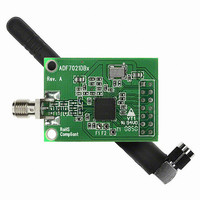EVAL-ADF7021-NDBZ2 Analog Devices Inc, EVAL-ADF7021-NDBZ2 Datasheet - Page 32

EVAL-ADF7021-NDBZ2
Manufacturer Part Number
EVAL-ADF7021-NDBZ2
Description
860 MHz To 870 MHz
Manufacturer
Analog Devices Inc
Type
Transceiver, FSKr
Datasheet
1.ADF7021-NBCPZ-RL.pdf
(64 pages)
Specifications of EVAL-ADF7021-NDBZ2
Frequency
860MHz ~ 870MHz
Lead Free Status / RoHS Status
Lead free / RoHS Compliant
For Use With/related Products
ADF7021-N
Lead Free Status / RoHS Status
Lead free / RoHS Compliant
ADF7021-N
DEMODULATION, DETECTION, AND CDR
System Overview
An overview of the demodulation, detection, and clock and
data recovery (CDR) of the received signal on the ADF7021-N
is shown in Figure 47.
The quadrature outputs of the IF filter are first limited and
then fed to either the correlator FSK demodulator or to the
linear FSK demodulator. The correlator demodulator is used
to demodulate 2FSK, 3FSK, and 4FSK. The linear demodulator
is used for frequency measurement and is enabled when the
AFC loop is active. The linear demodulator can also be used
to demodulate 2FSK.
Following the demodulator, a digital post demodulator filter
removes excess noise from the demodulator signal output.
Threshold/slicer detection is used for data recovery of 2FSK and
4FSK. Data recovery of 3FSK can be implemented using either
threshold detection or Viterbi detection.
An on-chip CDR PLL is used to resynchronize the received bit
stream to a local clock. It outputs the retimed data and clock on
the TxRxDATA and TxRxCLK pins, respectively.
TxRxDATA
TxRxCLK
LIMITERS
Figure 47. Overview of Demodulation, Detection, and CDR Process
Q
I
RECOVERY
CLOCK
DATA
AND
DEMODULATOR
CORRELATOR
FREQUENCY
LINEAR
MUX
MUX
THRESHOLD
DETECTION
DETECTION
2/3/4FSK
VITERBI
3FSK
Rev. 0 | Page 32 of 64
Correlator Demodulator
The correlator demodulator can be used for 2FSK, 3FSK, and
4FSK demodulation. Figure 48 shows the operation of the
correlator demodulator for 2FSK.
The quadrature outputs of the IF filter are first limited and then
fed to a digital frequency correlator that performs filtering and
frequency discrimination of the 2FSK/3FSK/4FSK spectrum.
For 2FSK modulation, data is recovered by comparing the
output levels from two correlators. The performance of this
frequency discriminator approximates that of a matched filter
detector, which is known to provide optimum detection in the
presence of additive white Gaussian noise (AWGN). This
method of FSK demodulation provides approximately 3 dB to
4 dB better sensitivity than a linear demodulator.
DISCRIMINATOR_BW
LIMITERS
Q
R4_DB(10:19)
I
Figure 48. 2FSK Correlator Demodulator Operation
FREQUENCY CORRELATOR
IF –
DISCRIM BW
f
DEV
DOT_PRODUCT
R4_DB7
IF
IF +
f
DEV
Rx_INVERT
R4_DB9
2FSK = +1, –1
OUTPUT LEVELS:
3FSK = +1, 0, –1
4FSK = +3, +1, –1, –3












